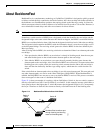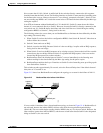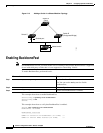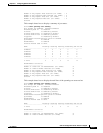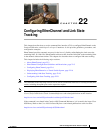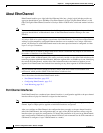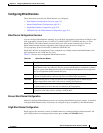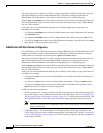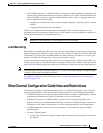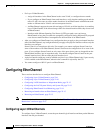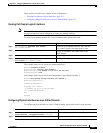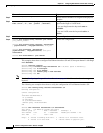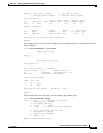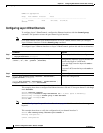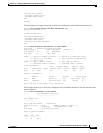
22-4
Software Configuration Guide—Release 15.0(2)SG
OL-23818-01
Chapter 22 Configuring EtherChannel and Link State Tracking
About EtherChannel
The protocol learns the capabilities of LAN port groups dynamically and informs the other LAN ports.
Once PAgP identifies correctly matched Ethernet links, it facilitates grouping the links into an
EtherChannel. The EtherChannel is then added to the spanning tree as a single bridge port.
Both the auto and desirable modes allow PAgP to negotiate between LAN ports to determine if they can
form an EtherChannel, based on criteria such as port speed and trunking state. Layer 2 EtherChannels
also use VLAN numbers.
LAN ports can form an EtherChannel when they are in different PAgP modes if the modes are
compatible. For example:
• A LAN port in desirable mode can form an EtherChannel successfully with another LAN port that
is in desirable mode.
• A LAN port in desirable mode can form an EtherChannel with another LAN port in auto mode.
• A LAN port in auto mode cannot form an EtherChannel with another LAN port that is also in auto
mode because neither port initiates negotiation.
IEEE 802.3ad LACP EtherChannel Configuration
Cisco IOS Release 12.2(25)EWA and later releases support IEEE 802.3ad LACP EtherChannels. LACP
supports the automatic creation of EtherChannels by exchanging LACP packets between LAN ports.
LACP packets are exchanged only between ports in passive and active modes.
The protocol learns the capabilities of LAN port groups dynamically and informs the other LAN ports.
Once LACP identifies correctly matched Ethernet links, it facilitates grouping the links into an
EtherChannel. The EtherChannel is then added to the spanning tree as a single bridge port.
Both the passive and active modes allow LACP to negotiate between LAN ports to determine if they can
form an EtherChannel, based on criteria such as port speed and trunking state. Layer 2 EtherChannels
also use VLAN numbers.
LAN ports can form an EtherChannel when they are in different LACP modes as long as the modes are
compatible. For example:
• A LAN port in active mode can form an EtherChannel successfully with another LAN port that is
in active mode.
• A LAN port in active mode can form an EtherChannel with another LAN port in passive mode.
• A LAN port in passive mode cannot form an EtherChannel with another LAN port that is also in
passive mode, because neither port initiates negotiation.
LACP uses the following parameters:
• LACP system priority—You may configure an LACP system priority on each switch running LACP.
The system priority can be configured automatically or through the CLI. See the “Configuring the
LACP System Priority and System ID” section on page 22-13. LACP uses the system priority with
the switch MAC address to form the system ID and also during negotiation with other systems.
Note The LACP system ID is the combination of the LACP system priority value and the MAC
address of the switch.
• LACP port priority—You must configure an LACP port priority on each port configured to use
LACP. The port priority can be configured automatically or through the CLI. See the “Configuring
Layer 2 EtherChannels” section on page 22-10. LACP uses the port priority with the port number to
form the port identifier.



